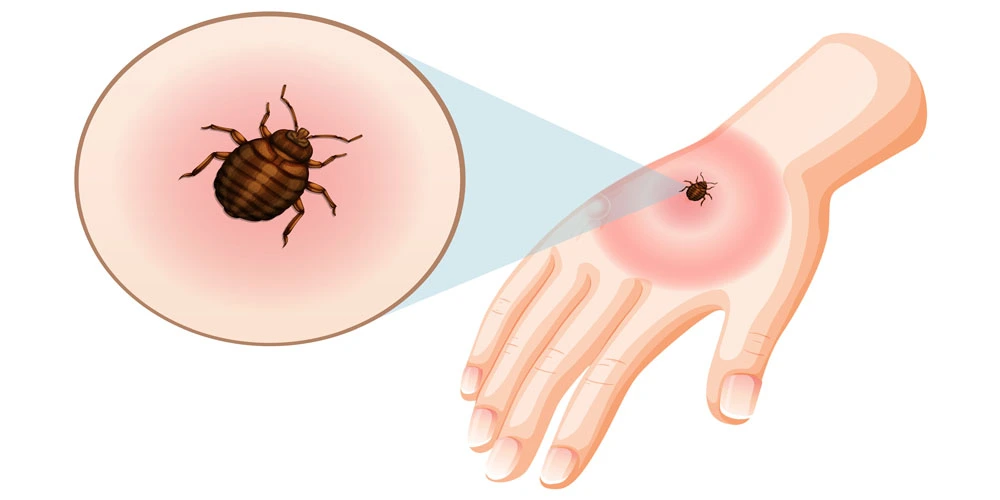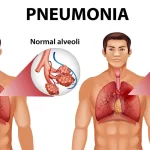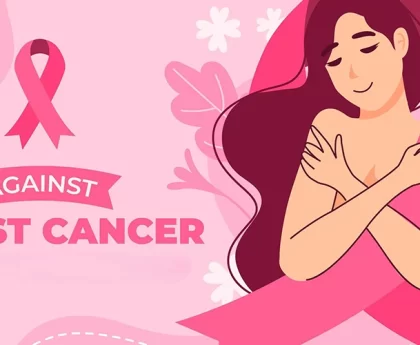Chagas Disease: Types, Symptoms, Causes & Prevention also known as American trypanosomiasis, is a parasitic infection caused by the protozoan parasite Trypanosoma cruzi. It is primarily found in the Americas, especially in Central and South America. Chagas disease is primarily transmitted to humans through the bite of infected triatomine bugs (also known as “kissing bugs”) or through other routes of transmission, such as congenital transmission (from mother to child), blood transfusions, organ transplantation, and consumption of contaminated food or beverages.
The disease can have acute and chronic phases. In the acute phase, individuals may experience mild or no symptoms, making it difficult to diagnose. However, if left untreated, the infection can progress to the chronic phase, which can lead to severe health issues. Some of the chronic symptoms and complications of Chagas disease include heart problems (cardiomyopathy), digestive issues, and neurological disorders.
Chagas disease is a significant public health concern in affected regions, and efforts are made to control the transmission of the parasite and provide treatment for those infected. Treatment is most effective when administered early in the course of the disease. Preventive measures, such as improving housing conditions to reduce contact with infected bugs and screening blood donors for the parasite, are also important in controlling the spread of Chagas disease.
Types of Chagas Disease
Chagas disease, caused by the parasite Trypanosoma cruzi, can be categorized into two main phases: the acute phase and the chronic phase.
These phases represent the different stages of the disease and have distinct characteristics.
- Acute Chagas Disease:
– The acute phase typically occurs in the first few weeks to months after infection with Trypanosoma cruzi.
– Symptoms during the acute phase can be mild and often go unnoticed. However, they can include fever, fatigue, body aches, and swelling at the site of the insect bite (if transmitted through a triatomine bug).
– In some cases, acute symptoms can be more severe, with complications such as myocarditis (inflammation of the heart muscle) or meningoencephalitis (inflammation of the brain and spinal cord).
– The acute phase usually resolves on its own, and many individuals enter an asymptomatic or indeterminate phase. - Chronic Chagas Disease:
– The chronic phase can develop over many years, even decades, after the initial infection.
– During the chronic phase, the disease may progress silently without obvious symptoms in many individuals, and they are often unaware of the infection.
– Some people may experience chronic symptoms, which can vary depending on the organs affected. The two main forms of chronic Chagas disease are:
a. Cardiac Chagas Disease: This form affects the heart and can lead to complications such as cardiomyopathy (enlargement and weakening of the heart), arrhythmias, and heart failure.
b. Digestive Chagas Disease: This form affects the digestive tract, including the esophagus and colon, and can lead to issues like megaesophagus (enlargement of the esophagus) and megacolon (enlargement of the colon).
– In severe cases, chronic Chagas disease can be life-threatening, particularly when it leads to heart-related complications.
It’s important to note that some individuals infected with Trypanosoma cruzi may remain in an “indeterminate” phase throughout their lives, showing no symptoms or organ damage. Regular medical check-ups and testing are essential to monitor and manage the disease, especially for those at risk or living in regions where Chagas disease is endemic. Early diagnosis and treatment during the acute phase can be crucial for preventing the progression of the disease to its chronic, potentially severe forms.
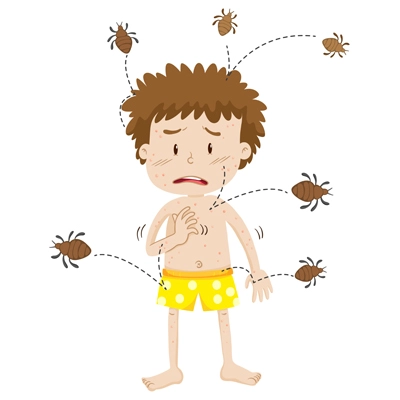
Symptoms of Chagas Disease
Chagas disease, caused by the parasite Trypanosoma cruzi, can have a wide range of symptoms, depending on the stage of infection. The disease is generally divided into two main phases: the acute phase and the chronic phase.
Here are some of the common symptoms associated with each phase:
Acute Phase:
- Fever: Many people with acute Chagas disease experience a mild fever.
- Fatigue: General feelings of tiredness and weakness are common.
- Body Aches: Muscular and joint pain can occur.
- Swelling at the Infection Site: If the disease was transmitted through the bite of an infected triatomine bug, a characteristic localized swelling (chagoma) may appear at the site of the insect bite.
- Enlarged Lymph Nodes: Swollen lymph nodes near the site of infection may be observed.
- Generalized Swelling: Some individuals may experience swelling in the face and extremities.
- Nausea and Vomiting: Gastrointestinal symptoms, including nausea and vomiting, can occur.
- Enlarged Liver or Spleen: Hepatomegaly (enlarged liver) and splenomegaly (enlarged spleen) are possible symptoms.
- Chronic Phase:
The chronic phase can develop over many years and often progresses without noticeable symptoms. However, when symptoms do appear, they can vary widely, depending on the specific form of the disease (cardiac or digestive) and the extent of organ involvement. Common chronic Chagas disease symptoms include:
Cardiac Symptoms:
- – Palpitations
– Chest pain or discomfort
– Shortness of breath
– Fatigue
– Edema (swelling of the legs and ankles)
– Fainting (syncope)
– Arrhythmias (irregular heart rhythms)
– Cardiomyopathy (enlargement and weakening of the heart
Digestive Symptoms (Digestive Chagas Disease):
- – Difficulty swallowing (dysphagia)
– Megaesophagus (enlargement of the esophagus)
– Regurgitation of food or saliva
– Heartburn or acid reflux
– Abdominal pain
– Constipation
– Megacolon (enlargement of the colon)
It’s important to note that many people with chronic Chagas disease may remain asymptomatic or have very mild, non-specific symptoms. Chronic Chagas disease can lead to severe complications, especially if left untreated, and it can be life-threatening, particularly when it affects the heart.
Early diagnosis and appropriate medical care are critical for individuals with Chagas disease, as treatment during the acute phase is more effective in preventing the disease from progressing to its chronic, potentially severe forms. Regular medical check-ups and monitoring are essential for those at risk or living in areas where Chagas disease is endemic.
Causes of Chagas Disease
Chagas disease is caused by the protozoan parasite Trypanosoma cruzi. The disease is primarily transmitted to humans through contact with infected triatomine bugs, also known as “kissing bugs.” These insects are the main vectors responsible for transmitting the parasite.
However, Chagas disease can also be spread through various other routes:
- Vector-Borne Transmission: The most common mode of transmission occurs when infected triatomine bugs bite humans and deposit their feces near the bite wound. The feces contain the parasite, which can then enter the body through mucous membranes, breaks in the skin, or the bite wound. When the person scratches the bite area, the parasite can be introduced into the bloodstream. This is the primary way Chagas disease is transmitted in endemic areas.
- Congenital Transmission: Pregnant women who are infected with Trypanosoma cruzi can transmit the parasite to their babies during pregnancy or childbirth. This is known as congenital transmission and is a significant mode of transmission in areas where Chagas disease is endemic.
- Blood Transfusions and Organ Transplants: In regions where Chagas disease is prevalent, there is a risk of transmission through blood transfusions and organ transplants from infected donors.
- Oral Transmission: Chagas disease can be transmitted orally through the consumption of food or beverages contaminated with the parasite. This form of transmission can occur when infected triatomine bugs defecate on fruits, vegetables, or other food items, and the parasite is ingested unknowingly.
- Laboratory Accidents: There have been rare cases of Chagas disease transmission through laboratory accidents involving the handling of contaminated materials or accidental exposure to the parasite.
- Mother-to-Child Transmission: In addition to congenital transmission, mothers can transmit the infection to their infants through breastfeeding or close contact with contaminated hands or other body fluids.
It’s important to note that Chagas disease is endemic in certain regions of the Americas, primarily in Central and South America, where the infected triatomine bugs are prevalent. In non-endemic regions, such as the United States and Europe, cases of Chagas disease may occur among individuals who have lived or traveled in endemic areas or through congenital or other forms of transmission.
Preventive measures, such as improving housing conditions to reduce contact with infected bugs, screening blood donors for the parasite, and raising awareness about the disease, are essential for controlling its spread. Early diagnosis and treatment are critical to prevent the progression of Chagas disease to its chronic and potentially severe forms.
Prevention of Chagas Disease
Preventing Chagas disease primarily involves reducing the risk of exposure to the parasite Trypanosoma cruzi, which is primarily transmitted by triatomine bugs, also known as “kissing bugs.”
Here are some key preventive measures:
- Housing and Environmental Measures:
– Improve housing conditions: Repair or replace housing materials that allow the entry of triatomine bugs, such as adobe, thatch, or mud walls. Installing screens on doors and windows can help keep bugs out.
– Maintain cleanliness: Keep your home and sleeping areas clean and free from cracks, crevices, and debris where bugs can hide. - Personal Protection:
– Use insect repellent: Apply insect repellent to exposed skin and clothing, especially when spending time outdoors or in areas where kissing bugs are prevalent.
– Wear protective clothing: If you are in an area where kissing bugs are common, wear long sleeves and pants to minimize exposed skin.
– Bed netting: Use bed nets treated with insecticides, especially in areas where kissing bugs are known to transmit the parasite. - Pet Safety:
– Keep pets indoors at night or provide them with safe sleeping quarters.
– Check pets for kissing bugs and remove them safely. - Vector Control:
– Eliminate kissing bugs: If you find kissing bugs in or around your home, safely remove and dispose of them, or consult local vector control authorities for assistance.
– Chemical control: Insecticides can be used to control kissing bugs in and around homes, but this should be done by trained professionals. - Blood and Organ Donation Screening:
– In regions where Chagas disease is endemic, blood banks screen donated blood for the presence of Trypanosoma cruzi to prevent transmission through blood transfusions.
– Donor screening should also be implemented for organ transplantation to reduce the risk of transmission. - Safe Food Practices:
– Avoid consuming food or beverages that might be contaminated with the parasite, particularly in endemic regions.
– Wash fruits and vegetables thoroughly and avoid using unprocessed sugar cane products. - Pregnancy and Childbirth:
– Pregnant women should receive routine prenatal care and be tested for Chagas disease to identify and manage potential congenital transmission.
– Follow medical recommendations to reduce the risk of transmission during childbirth and breastfeeding. - Education and Awareness:
– Raise awareness about Chagas disease in communities at risk to ensure that people understand the risks and how to protect themselves.
Preventing Chagas disease is essential, especially in endemic areas, as it can help reduce the transmission of the parasite and the development of chronic, potentially severe forms of the disease. Early diagnosis and treatment during the acute phase of the disease are also critical to prevent its progression. If you suspect you have been exposed to Chagas disease or are experiencing symptoms, seek medical attention promptly.
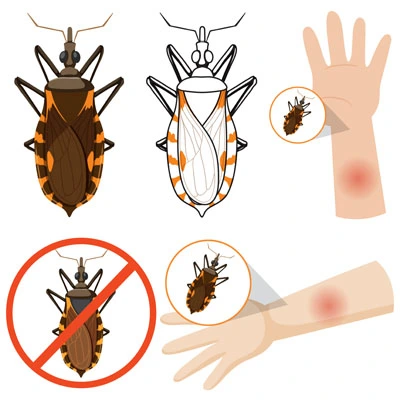
Is Chagas disease curable?
Chagas disease is treatable, especially when diagnosed and treated during the acute phase of the infection. However, the effectiveness of treatment diminishes as the disease progresses to the chronic phase. The treatment primarily involves antiparasitic medications, such as benznidazole and nifurtimox, which are used to kill the parasite Trypanosoma cruzi.
Here’s how the treatment of Chagas disease works:
- Acute Phase Treatment: When diagnosed early during the acute phase, antiparasitic treatment with medications like benznidazole or nifurtimox can effectively eliminate the parasite from the body. Treatment during this phase can help prevent the development of chronic Chagas disease and its associated complications.
- Chronic Phase Treatment: The effectiveness of antiparasitic treatment diminishes as the disease progresses to the chronic phase. In the chronic phase, the parasite is less abundant in the bloodstream, and the focus shifts to managing the complications and symptoms of the disease. This may include treatments for heart-related issues, digestive problems, or other organ involvement.
It’s important to note that treatment in the chronic phase may not fully cure the disease but can help manage and alleviate some of the symptoms and complications associated with Chagas disease.
The decision to initiate treatment and the choice of medication should be made by a healthcare professional after a thorough evaluation, considering factors such as the patient’s age, the stage of the disease, the presence of symptoms, and potential side effects of the medications. Treatment may not be recommended for all individuals, and the risks and benefits need to be carefully assessed.
Early diagnosis, especially during the acute phase, is crucial for the most effective treatment outcomes. Regular medical check-ups and monitoring are important for individuals who have been exposed to Chagas disease or live in endemic areas. Preventive measures to reduce the risk of infection, as mentioned in a previous response, are also vital in controlling the spread of the disease.
Does Chagas Disease affect the brain?
Chagas disease primarily affects the heart and digestive system, but it can also have neurological manifestations, affecting the central nervous system. The neurological complications associated with Chagas disease are typically observed in the chronic phase of the infection, and they can be diverse.
Here are some ways in which Chagas disease can affect the brain and nervous system:
- Meningoencephalitis: In rare cases, Chagas disease can lead to inflammation of the membranes surrounding the brain and spinal cord, a condition known as meningoencephalitis. This can result in symptoms such as headaches, confusion, altered mental status, and in severe cases, seizures.
- Peripheral Neuropathy: Chagas disease can cause damage to peripheral nerves, leading to peripheral neuropathy. This condition can result in symptoms like weakness, numbness, tingling, and pain in the extremities.
- Psychiatric and Cognitive Symptoms: Some individuals with Chagas disease may experience psychiatric symptoms, such as depression, anxiety, and cognitive impairment.
- Stroke: There have been reports of Chagas disease increasing the risk of stroke, although this is not a common manifestation.
It’s important to note that neurological complications are relatively rare in Chagas disease, and the majority of individuals with the infection do not experience these symptoms. The severity and frequency of neurological manifestations can vary among individuals.
Chagas disease is more commonly associated with cardiac complications (cardiomyopathy) and digestive problems (especially in the esophagus and colon). Regular medical check-ups and monitoring are essential for individuals with Chagas disease to detect and manage any potential neurological or other complications. Early diagnosis and appropriate medical care are crucial to prevent the progression of the disease to its more severe forms.
Foodborne Diseases: Types, Symptoms, Causes & Prevention
Irritable Bowel Syndrome: Types, Symptoms, Causes & Prevention
Breast Cancer: Types, Symptoms, Causes, & Prevention
Migraine: Types, Symptoms, Causes & Home Remedies
Understanding Syncope: Symptoms, Causes & Home Remedies
Freckle: Symptoms, Causes, Prevention & Need to Know

